Article written by Grace Vachon
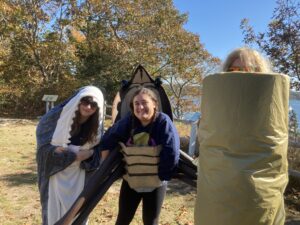
I had fun being involved with the educational programs this year, including the Halloween event shown here.
To say that this year was quite a year would be an understatement. When I chose to work with Waquoit Bay National Estuarine Research Reserve (WBNERR) and the Friends this year, I had only a very faint idea of what to expect. Would I be planning programs? Teaching students? Designing brochures? I felt nervous as I drove past the gate toward WBNERR’s visitor center on my first day in October. It was an unknown place and a new experience. It did not know what to expect. However, I was greeted by a charming old house overlooking the glistening blue waters of Waquoit Bay, and I suddenly felt a little less nervous.
This year, I was assigned to work with WBNERR’s School and Interpretive Programs Coordinator Jayne DiCandio, as well as Nancy Church from the Friends. On my first day, Jayne gave me a quick tour of the property and briefed me on my project for the year, which was to design and execute a program about ocean plastics. She did not specify what kind of program this had to be. Could it be for the public? Could it be for people of all ages or only for school kids? I am very self-directed, so I was excited to take this assignment in the direction I wanted it to go in.
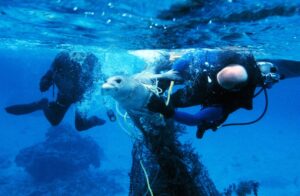
Plastic trash that ends up in our oceans is extremely harmful to marine life like seals, turtles, fish, and birds. Animals, such as the seal here, can become caught in marine debris. They can also suffocate or become exposed to harmful chemicals when they consume debris.
Through the fall, I conducted research about ocean plastics and looked into what other organizations had already done to educate students about the topic. I already knew that plastic was an issue, but my research really put the scale of the problem into perspective. First of all, consider what happens to all of the plastic that we produce. You may think that a lot of that plastic gets recycled, but in reality, only about 9% of plastic waste is recycled (source). The rest of that plastic ends up either in a landfill or in the environment somewhere, such as in the ocean. In fact, I learned that about eight million tons of plastic waste enters the world’s oceans every year (source). Considering that one ton is equivalent to 2,000 pounds, that is quite a lot of plastic! Once that plastic escapes into the ocean, it becomes a danger to sea life like turtles, fish, seals, and sea birds who can become tangled in it or ingest it. Also, plastic can be found almost anywhere, from high in the atmosphere to deepest depths of the ocean. Even as deep as the Marianna’s Trench, which is 36,000 feet below sea level, a group of Japanese scientists surveying the area found a plastic bag just floating there (source).
Especially harmful due to their small size are microplastics, which are plastic fragments that are less than 5 millimeters in length. They form when plastic waste is exposed to elements like wind, waves, and sunlight. While I was conducting research and brainstorming activities, I stumbled across an activity where students used microscopes to look for microplastics in samples of sand. Jayne and I collected sand from several beaches in Falmouth. However, we failed to find any microplastics after tirelessly looking through the samples. Therefore, we began to explore another idea. There were a few major storms this winter that caused a ton of trash to wash up on South Cape Beach, so Jayne and I decided that we were going to create “mini sandboxes” with small pieces of trash and organic materials like shells, feathers, sticks, and seaweed. The goal was for students to sift through the sand and sort the items that they found into the categories of “trash” or “organic material.” We created these sandboxes by cutting up or crushing the materials into tiny pieces and hiding them in large containers of sand. In a way, we were creating our own microplastics. This activity was meant to teach students about how microplastics form and how they can end up in beach sand when tides move them around. In March, I combed out the final details of the activity and presented it to a Girl Scout troop for World Thinking Day, which is a day recognized by the Girl Scouts worldwide to get young people thinking about how they can improve the world that they live in. In May, one of WBNERR’s park interpreters, Emily McBride, delivered the program to a group of 6th graders from a school in Dedham, Massachusetts. Although I could not be there to deliver the program that day, I was glad to hear from Emily that it was a success and that the kids had fun.
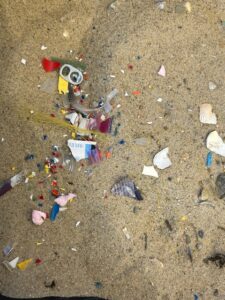
Microplastics are tiny plastic fragments. Due to their small size, they can be found almost anywhere including in the air, water, soil, and even inside our bodies and food. Here are some of the “microplastics” that we hid in the sand.
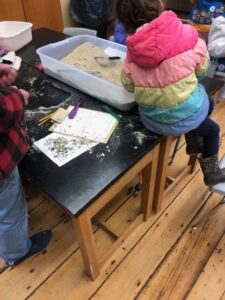
The Girl Scouts digging through the sand!
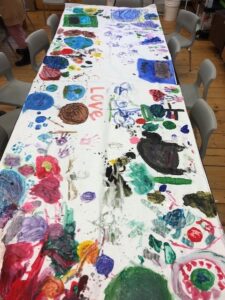
World Thinking Day was so much fun. Here is the banner that the girls made showing what they are going to do to help the Earth.
At the same time that I had been planning plastics programming for school kids, I was working with WBNERR staff to pilot a citizen science project which we ended up calling Tackle the Trash. This is an initiative where community members are encouraged to pick up trash when visiting local beaches. Only beaches in Falmouth or Mashpee count. Then, they can visit WBNERR’s website, where there is a page dedicated to the project, and fill out an online data form where they report what they found. In the winter, Tonna-Marie (WBNERR’s director) connected me with Nicole Vandale, a graduate student fellow from Northeastern University who is working with the Woods Hole Oceanographic Insititute on plastics research. I already had a rough idea of the project that I wanted to create, but Nicole provided me with some additional insight. I also got connected with Laurie Tompkins, WBNERR’s volunteer coordinator, who helped me put together a webpage and flyer for the project. The webpage is now up on WBNERR’s website and includes the online form as well as information about the harms of plastic and getting involved with the project. On June 24th, Nicole and I presented the project to a small audience of interested community members and WBNERR staff. Moving forward, the goal is for WBNERR’s next AmeriCorps member to design a way to organize or present the data. Hopefully, the data can be used to help WBNERR focus their anti-littering and anti-plastic education efforts.
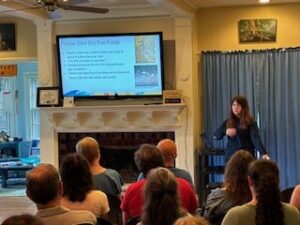
Me presenting my “Tackle The Trash” project
Creating Tackle the Trash was one way for me to get the community involved in environmental protection efforts. However, my work with the Friends this year was where I became more involved with community outreach efforts through writing and graphic design. Specifically, Lucinda from the Friends and I have been working really hard this year to create a self-guided tour for the upcoming 5K Walk for the Wild on October 13th. For the tour, I have designed ten infographics providing general information about plants, wildlife, and landmarks found in the area or along the walking path. Some of the topics that I cover include herring runs, PFAS contamination, invasive plants, and vernal pools. I also helped Lucinda film and edit a few videos that will also be part of the tour. These include interviews with Joan Tavares Avant, an elder of the Mashpee Wampanoag Tribe, and Talia Landry, a youth educator for the Tribe. In addition to the Walk for the Wild guided tour, I have had a blast writing articles for the Friends website and newsletter. Some of the topics that wrote about this year included rabies on Cape Cod, the restoration of the Quashnet River Valley, Osprey, pollinator gardens, vernal pools, and invasive plants.
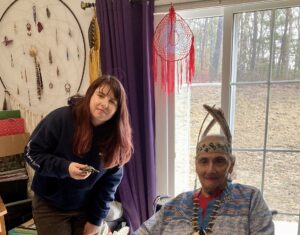
Me with Joan Avant at her home after the interview.
Overall, it has been a joy to work with Waquoit Bay Research Reserve and the Friends this year. I have learned so much and met so many interesting and wonderful people. I especially enjoyed learning about Osprey and the Mashpee Wampanoag Tribe. Observing the Old Ladies Against Underwater Garbage (OLAUG) collect trash at the bottom of pond with Lucinda this July was also a highlight of the year. After this year, I have a better understanding of my interests (including my likes and dislikes) and future career goals. I look forward to visiting and staying in touch with the people and places that I served with this year. Overall, I feel like the projects that I completed over the course of the year were a success and will have a lasting impact on the community. Thanks everyone for a great year!
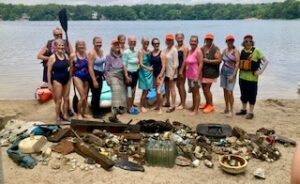
The Old Ladies Against Underwater Garbage with their haul on July 9th, 2024.
